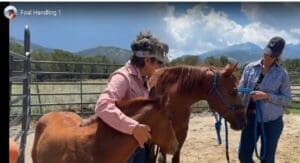Do you want to learn to ride your horse without a bridle?
To me, the ultimate sign of true unity, trust and respect between a horse and the rider is when you can remove the bridle, have nothing on his head, and have the horse perform as well or better than he did in the bridle.
The ideal bridle-less horse is well-tempered and well-trained. He has a calm and willing attitude, a strong work ethic, good manners and he hates to get in trouble. He tries hard most of the time and is sensitive to the aids of the rider. He accepts your authority and generally tries to please you. Although no horse is perfectly behaved all of the time, the ideal bridle-less horse is well-behaved almost all of the time.
You don’t just take the bridle off one day–there is much preparation work that must be done. A neck rope is an important tool in this transition. You can use the neck rope to turn, stop, slow down or back up. Remember, don’t just trade reins for the neck rope. Try to ride using your seat legs and arm position to cue the horse and only using the neck rope if needed for reinforcement when your horse needs help hearing your cues.
(Search “bridleless” on my site for detailed step-by-step directions on safely transitioning to bridleless riding.)
Get your Julie Goodnight Neck Rope here: Neck Rope
Take your time and take small steps. If you have any doubts about your horse’s obedience or responsiveness, do not move on to the next step. Keep working where you are until you have complete confidence in your horse.
No matter how long it takes–a month, a year or longer–you’ll be making progress at each step and you’ll enjoy the journey. When you get to the point that you take off the bridle, it is incredibly exhilarating and rewarding–that’s when the fun really begins!


